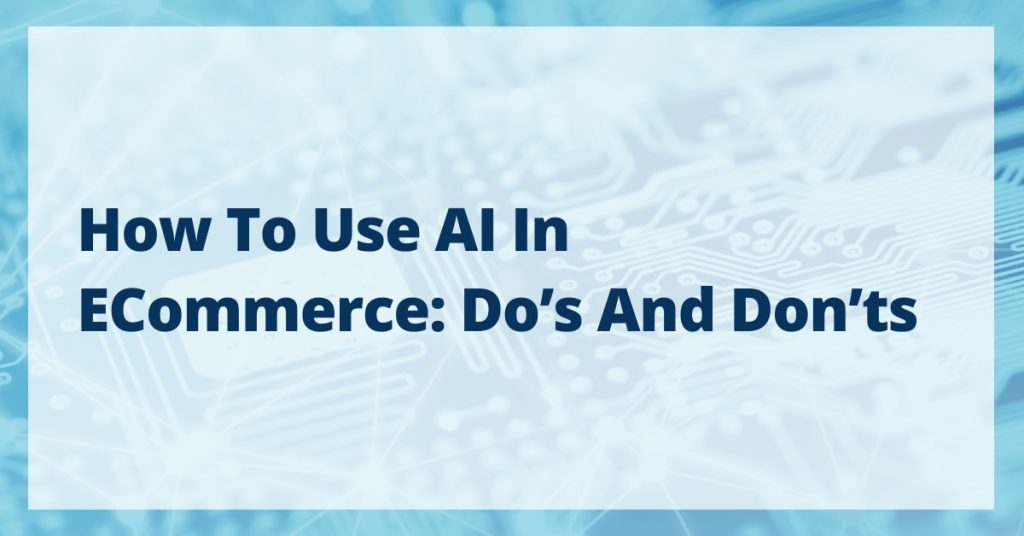With many loud voices surrounding the viral bandwagon of artificial intelligence, pinpointing exactly what AI can and can’t do can be difficult.
On one side, AI enthusiasts claim that computers can do everything humans can but better. On the other side, AI doubters reject everything AI.
The good news? As an eCommerce retailer, you don’t have to choose a side. Instead of handing your whole store over to AI, you can integrate it here and there into your processes to see how it works and whether it improves your bottom line.
Plus, you don’t have to start from scratch. We’ll share what artificial intelligence can offer, what’s working for other eCommerce stores, and which do’s and don’ts you need to be mindful of.
AI in eCommerce 101
AI in eCommerce means using artificial intelligence tools and techniques in your eCommerce store to improve the online shopping experience for your customers and yourself.
For example, say a customer bought summer dresses from your online clothing store a while ago. In that case, AI will analyze those purchases and the customer’s browsing behavior to develop personalized product recommendations that align with their style preferences to help them find what they want on their next visit.
Similarly, you can expect the following benefits by using AI in your eCommerce store:
- Self-service customer support: Instead of having multiple customer agents 24/7/365 available for live chat, you can implement chatbots to respond to most of the simpler, more straightforward queries to reduce your customer support spending.
- Personalized marketing: AI-based tools can digest all the relevant data you throw at them to generate actionable marketing data for different customer segments, ranging from the correct time to message a customer to relevant products for upselling a buyer.
- Improved processes: With AI-based analytics, you always have a sidekick optimizing your inventory management to let you know when to order more items or offer a discount to get older items out.
How to use AI in eCommerce
Here are 10 ways you can use AI in your eCommerce store:
1. Innovate your customer experience
To be memorable as an online retailer, you have to practice innovation. Instead of trying to become the next Amazon, consider positioning your business as a brand other businesses would like to emulate.
One of the best ways to do that? Artificial intelligence.
Since AI technology is relatively new, there are tons of ways you can combine it with online shopping to offer something unique to your customers.
For example, check out Sephora’s Virtual Artist. It’s an augmented reality (AR) tool in Sephora’s app that uses AI to detect eyes, lips, and cheeks for product placement. Customers can use it to virtually try an infinite library of makeup products to see how they look before making a purchase.
And it’s just not Sephora. You can also draw inspiration from Stitch Fix, an American personal styling subscription service.
Stitch Fix requires customers to fill out a Style Profile at sign-up, which it feeds to its AI-based algorithm. The algorithm analyzes the customer’s submission to prepare a rank-ordered inventory of clothing they might love. In short, the customer gets what they want without having to scan the whole catalog for relevant apparel pieces.
2. Assist customers while shopping
Shopping online for consumables, sparkling toys, and technology products is often easy. But shopping for shoes and clothing quickly becomes 5D chess with infinite sizing charts.
If you don’t want customers to leave your online store just because you didn’t cover the shoe size in the format they understand, assist them by explaining how the size looks compared to what they’re familiar with.
While you could do this by reinforcing your customer support staff, a better alternative might be configuring an AI-powered virtual assistant that handles those recurring customer queries by itself and gives instant answers to streamline the customer journey.
Here’s how an intelligent chatbot would handle a query about a women’s shoe size U.S. 10.5:
Question: What does U.S. size 10.5 (women) mean?
Answer: This means that the shoe is size 10.5 based on the American sizing system for shoes designed for women.
Here are the equivalent sizes in other sizing systems, if that’s what you’re familiar with:
3. Offer a personalized shopping experience
According to a 2023 Marigold report, 79% of customers love getting recommendations based on their past purchases. In other words, recommending relevant products to customers not only helps you increase sales but also boosts customer loyalty.
AI algorithms can help you offer such tailor-made experiences to your customers. The algorithm can analyze the customer’s purchase history, browsing behavior, and profile details and make product recommendations in addition to upselling and cross-selling opportunities.
Amazon is a great example of this. Its recommendation system uses AI to analyze customers’ previous purchases, customer interactions, and product ratings to generate personalized recommendations.

4. Optimize your supply chain
In Q1 of 2023, the eCommerce sales in the U.S. stayed a little above $250 billion. But for Q4, that figure reached almost $325 billion.
The reason? Seasonal holiday sales — with Black Friday, Cyber Monday, and Christmas in the mix.
To make the most of these seasonal sales and trends, you need to keep your product stock high enough to meet the peak demand.
That said, overstocking isn’t the optimal solution, as you could be left with extra items at the end of the season with no way to make reasonable profits.
Instead, you can rely on AI-powered tools to analyze historical data, seasonality, and trends and recommend optimal inventory levels for different items.
5. Detect fraudulent orders
You can use AI-based systems to detect and prevent fraudulent orders before they occur.
For instance, say a customer who typically buys budget headphones from you suddenly orders a high-end laptop, a 65-inch 4K TV, and a PlayStation 5 all at the same time. Seems a little suspicious, right?
You can flag questionable orders like that by configuring an algorithm to compare orders placed with the customer’s prior transactional history to see if there’s a mismatch.
After that, you can have a team member manually review the order, check for device fingerprint, and ask for additional verification.
6. Empower your search functionality
One great way to encourage customers to shop repeatedly from your online stores is to make finding products easier.
And how your website’s search works has a lot to do about that.
With AI, you can improve your search functionality beyond what users typically expect from online stores.
For instance, you can add:
- Voice-based search: Let users look for products by entering their queries via voice.
- Customized search: Personalize the search results based on the previous customer behavior.
- Image-based search: Enable customers to take photos or upload images and search your store for related products, as ASOS does.

7. Optimize your marketing campaigns
Even if you collect a lot of customer data, it doesn’t amount to much if you can’t use it to your advantage. And without artificial intelligence, that wasn’t really an option unless you had a large marketing team and robust marketing platform to make sense of all the data.
But with artificial intelligence taking much of the work off your hands, you can use all that customer data to approach your target customers at the right place and time.
For instance, you can use AI in marketing via:
- Intelligent emails: Configure algorithms to send emails at the perfect time — the time when it’s highly likely that the recipient will open and click on your email.
- Timely reminders: Implement a marketing automation tool that self-learns from successful messages and finds the optimal time to approach customers who abandon carts.
- Replenishment messages: Set up replenishment messaging on consumables (e.g. makeup, cosmetics, and vitamins) that tracks how long it takes customers to place another similar order and uses that data to adjust when to send replenishment reminders.
8. Analyze social media feedback
Manually scanning hundreds of comments over every post you make on Instagram, Facebook, and X (formerly known as Twitter) isn’t feasible. That said, it’s a valuable source of data that lets you know your standing in front of potential customers.
With AI solutions, you can measure your customer experience without doing all that menial work.

For example, check out Agorapulse. It scans the relevant social media platforms, finds out what’s working for or against you, and comes up with recommendations to excel in the social media ecosystem.
9. Get insights from customer reviews
Like social media comments, customer reviews on the online store and external integrations can be problematic.
Still, your future customers will check these reviews to see if you’re worth shopping with. If they don’t see positive progress in customer experience over time, they might not shop with you.
With AI tools, you can also scan customer reviews and get meaningful insights you can implement on your online store to improve your customer relationship.

For instance, Revuze lets you automatically collect, identify, and analyze customer feedback from several sources to forecast what customers want from your eCommerce brand.
10. Adjust product prices in real time
Unlike in a physical store, you don’t have to replace price stickers on the aisle or products in your online store. In other words, the eCommerce industry lets you increase or decrease product prices instantly to tackle changing market trends and grow your conversion rates.
That said, staying on top of the market trends of every item you sell isn’t always humanly possible. Instead, you can rely on AI to help you adjust product prices in real time based on market data.

For example, you can try out Competera if you want to leave price adjusting to AI.
AI in eCommerce: Do’s
While artificial intelligence has a lot to offer in online shopping, it’s better to only use it in places where it offers substantial advantages without any major risks.
Do use AI to offer personalized experiences
Using AI is a great way to offer personalized user experiences since the AI algorithms can predict what customers might like based on their data profiles.
For instance, if someone searches for minimal shirts, provide them with your clothing store’s must-buys for a capsule wardrobe. Similarly, you can send customized text messages, provide custom solutions, and interact with customers on a personal level with AI tools.
Do rely on AI to analyze large amounts of data
AI lets you make better use of data by helping you find patterns, trends, and insights you won’t find by looking at the data yourself.
Use AI-based tools to get actionable insights from granular data on customers, financial situations, and supply lines.
Do employ AI to deal with predictable problems
AI is excellent at solving predictable problems that it’s trained on. For instance, since AI already knows that an equivalent men’s shoe size of EUR 44 is U.S. 10.5–11, it will return an instant result for customers looking for that information.
In addition, if customers ask for information about refunds, shipping, and delivery, you can let the chatbot digest related policies to provide appropriate answers.
Do share with customers that you’re using AI
Let the online shoppers know how, why, and where you’re using AI in your processes to ensure transparency, set expectations, and uphold privacy.

And since data privacy laws, like the GDPR (General Data Protection Regulation), require you to obtain customers’ explicit consent anyway before gathering data on them, you might as well kill two birds with one stone and be as transparent as possible about your practices.
Doing so will not only ensure that your business is legally compliant but also strengthen your case in front of your customers.
Do test and iterate AI before implementing it
AI isn’t always stable out of the box since it undergoes limited testing by QA testers. And if you implement it right away, it’ll end up causing problems instead of solving them.
To prevent that from happening, make sure to test and iterate the AI within your company and potentially at a limited scale on your store before rolling it out to the whole eCommerce store.
AI in eCommerce: Don’ts
Now that we’ve covered where and how to use AI, let’s highlight scenarios where using AI might cause you problems.
Don’t hand over your entire customer support to AI
Chatbots are incredible for answering quick questions regarding products. And that’s helpful when the shoppers are looking for answers.
But if they’re looking for solutions with empathy, you need human support agents. In short, keep using human customer reps to handle returns, missing items, and other similar issues.
Don’t use AI without human oversight
Even after all the testing and iteration, AI tools can produce questionable results. Have monitoring systems in place to ensure those issues don’t affect your eCommerce processes.
For example, if the AI-based inventory tool places a large order, human approval should be required before sending the order to the supplier. For example, Stitch Fix pairs its intelligence algorithm with human stylists who hand-pick the items from the list the algorithm prepares to avoid making a mess.

Don’t go against data regulations
AI depends on data. If you don’t have any data to analyze or train your machine learning algorithm, you can’t get AI to yield reasonable results. That said, you still need to ensure you abide by the data privacy regulations while working with the AI.
For example, if a particular customer doesn’t want you to store their data, don’t store their data. Doing so would violate most prevalent data privacy regulations, including GDPR and CPRA (California Privacy Rights Act).
Final thoughts: Using AI in your eCommerce business: Do’s and don’ts
Artificial intelligence is an excellent way to level up your eCommerce brand’s customer experience. You can start with personalized recommendations and go all the way to AI-driven innovations to position yourself as a customer-first brand with AI.
That said, even with all the AI-based insights, customers will leave your online store if they don’t get its content to load within 3–5 seconds.
If you’re looking for a hosting provider who’s up for the challenge and can act as a partner when you venture into artificial intelligence, check out Liquid Web enterprise hosting.

